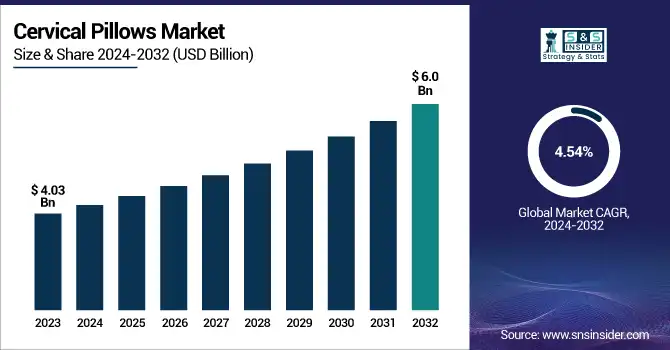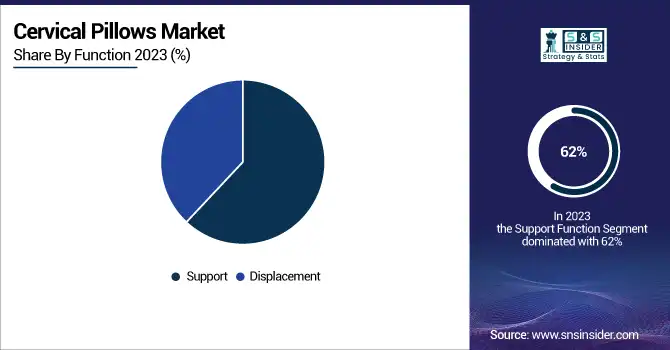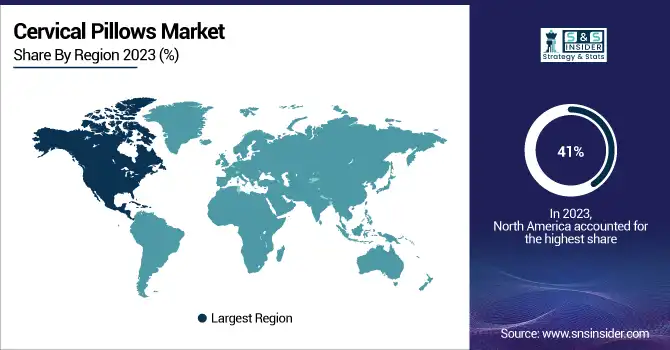Cervical Pillows Market Size Analysis
The Cervical Pillows Market was valued at USD 4.03 billion in 2023 and is expected to reach USD 6.0 billion by 2032, growing at a CAGR of 4.54% over the forecast period of 2024-2032.

To Get more information on Cervical Pillows Market - Request Free Sample Report
The cervical pillows market is experiencing an increase in demand as consumers become more aware of the various health benefits of using these pillows. It emphasizes the growing number of neck-related disorders and the increasing recommendations of physical therapists, physiatrists or other health care providers specifically in developed regions. Market volume growth has been tracked in the report that has been driven by increasing awareness about ergonomics and changing lifestyle. It segments users by age, profession, and medical needs, identifying working professionals and seniors as core demographics. Spending trends reveal out-of-pocket dominance, with limited insurance support in select countries. Additionally, it examines sales distribution channels, noting the rapid growth of online platforms. These insights offer a comprehensive view of market dynamics, user behaviour, and product adoption patterns shaping the future of cervical pillow demand. The orthotic cervical pillows market is being propelled by the rising cases of neck pain and spinal disorders due to sedentary lifestyles and extended screen time.
The U.S. cervical pillows market has shown steady growth, rising from USD 1.29 billion to USD 1.89 billion over the past decade, reflecting a CAGR of 4.34%. This growth is primarily fueled by increased awareness regarding spinal health, a rising prevalence of neck-related disorders, and growing consumer preference for ergonomic wellness products. High demand from working professionals and aging populations have also led to the growth of the cervical pillow market in the U.S., which has emerged as another key regional market for these products. This is due to high consumer awareness regarding sleep health and expenditures in healthcare. In 2023, the U.S. Centers for Disease Control and Prevention (CDC) reported about 20% of adults experienced chronic neck pain based on government statistics, making it a growing market for ergonomic solutions such as cervical pillows.
Cervical Pillows Market Dynamics
Drivers:
-
Rising prevalence of cervical spondylosis and neck-related disorders is accelerating demand for cervical pillows among all age groups.
Rising incidences of cervical spondylosis, chronic neck pain, and postural disorders are making cervical pillows highly sought after across the global consumer base. Lifestyle habits such as sedentary lifestyles, desk hammock jobs, and more screen time are playing a significant role in poor neck posture and spinal misalignment, thereby increasing the demand for ergonomic bedding solutions. This is why cervical pillows are universally advocated by physiotherapists and orthopedic experts to align the neck curvature properly, reduce pressure points, and help you sleep better. Consumers are increasingly becoming health conscious and taking preventive measures, helping the growth rate of cervical pillows in both developed as well as developing regions. Additionally, an aging population that is more prone to neck and spine problems is driving this trend. Fewer orthopedic sleep aides campaigns of wellness and health awareness would allow consumers to understand the benefits. The pillows are in high demand now since cervical disorders aren’t limited to a specific age group they are common amongst children to old population. The adaptation of technology and the diversification of products to meet different sleep patterns and preferences also add an extra appeal to consumers. Accordingly, the market is driving strong momentum, with greater product penetration in both online and offline retail channels across the global markets.
Restrain
-
High product cost and lack of awareness among rural populations are limiting widespread adoption of cervical pillows.
The relatively high cost of orthopedic pillows, especially those made with memory foam or featuring advanced ergonomic designs, remains a major barrier for widespread consumer adoption. In price-sensitive markets, particularly in developing nations, consumers often opt for traditional bedding solutions over specialized products like cervical pillows. Additionally, the lack of awareness in rural and semi-urban areas about the health benefits associated with these products significantly hinders market penetration. Limited access to physiotherapy, orthopedic care, and wellness education in such regions contributes to a general lack of understanding of posture-related health issues. Retail infrastructure in these areas also tends to focus on more generic or low-cost options, making it harder for premium cervical pillows to find shelf space or consumer attention. Furthermore, the market is fragmented with many local and unorganized players offering substandard alternatives at cheaper rates, which may lead to poor consumer experience and reduced repeat purchases. This price disparity also hampers trust in branded or medically-approved products. The absence of government or healthcare-driven awareness initiatives around preventive orthopedic care further compounds the issue. As a result, despite growing health consciousness in urban areas, the cervical pillows market faces challenges in achieving uniform growth across diverse income and geographic segments.
Opportunities
-
Integration of smart technology and eco-friendly materials in cervical pillows creates new product innovation opportunities.
Continuous incorporation of smart technology and sustainable materials in the design of cervical pillows is expected to generate great opportunities for product innovation and market differentiation. As the manufacturers continue to examine older products for improvement, these are just a few of the newer features being considered to enhance an already established category and add value to what the general public identifies as an orthopedic function. These tech-enabled innovations are not only appealing to younger, tech-savvy consumers but also offer added benefits to patients managing chronic conditions or recovering from injuries. At the same time, consumer demand for sustainable, non-toxic, and biodegradable materials in personal health products, like bedding, is on the rise. Recycled and hypoallergenic materials are also becoming popular among eco-friendly consumers, making brands that embrace ergonomic support as well as environmentally-safe and hypoallergenic characteristics attractive. Moving towards responsible production and high-performance design at all points is developing brand loyalty and leading to premium pricing of products. Companies that are very innovative are also obtaining patents and developing IP around smart cervical pillows technologies which gives them competitive advantage. These new product offerings are being sold as elements of larger sleep wellness ecosystems, which makes them even more enticing. The cervical pillows market is likely to benefit from the rising preference for next-generation solutions among consumer due to their multifunctional nature and sustainability.
Challenges
-
Inconsistent clinical validation and lack of standardized certifications weaken product credibility in the growing cervical pillows industry.
Limited clinical validation and absence of globally recognized certifications make it difficult for consumers to differentiate between effective and ineffective cervical pillows. Many commercially available products tout orthopaedic benefits but do not undergo rigorous testing or receive approval from medical authorities leading to disparate performance outcomes. This creates a credibility gap between manufacturers and consumers, especially in markets where regulatory oversight is minimal or unclear. With no standardized benchmarks for quality, ergonomics and material safety, manufacturers have the freedom to market subpar products that may not actually support cervical alignment or alleviate pain. However, as a result, users may find no relief, and in some cases, their symptoms worsen, leading to distrust in the entire category. Cervical pillows are not typically recommended in clinical practice unless they are supported by strong clinical evidence; they do not become widespread in therapeutic practice. Furthermore, insurers and health care systems typically don’t pay companies for such products, which limits their perceived value as a medical necessity. This leads to lower investment in R&D by companies as they don't feel assured that improvements in product quality will be rewarded in the marketplace, further stifling the embers of innovation. Addressing this challenge is essential for sustaining long-term growth and consumer trust in the cervical pillows market.
Cervical Pillows Market Segmentation Insights
By Type
In 2023, the standard cervical pillow segment held the largest revenue share, with over 42% of the global revenue. Its universal appeal and dedication to resolving pain everyone commonly shares has proven effective. A standard cervical pillow that is specially designed to support the neck and head during sleep, allowing the head to rest without disturbing the posture of the spine. Because they are simple and comparatively cheaper, they are preferred by consumers looking for reliable devices without advanced features.
Growing demand for standard cervical pillows is also being driven tables and desks with a U.S. Government emphasis on ergonomic health. For example, the Occupational Safety and Health Administration (OSHA) advises ergonomic interventions to prevent musculoskeletal disorders, including those resulting from improper sleeping position. Additionally, National Institutes of Health (NIH) studies reveal that more than 30% of adults experience broken sleep because of neck pain, further emphasizing the requirement for effective solutions such as standard cervical pillows. The segment is propelled owing to the manufacturers’ efforts to improve product quality through materials such as memory foam and bamboo fiber that are durable and comfortable. Meanwhile, thanks to e-commerce platforms, these products are more accessible than ever, with consumers benefiting from detailed product descriptions and reviews to simplify purchasing decisions. Moreover, partnerships formed by healthcare providers and manufacturers have driven up consumer confidence in basic cervical cushions as a preventive measure for chronic neck pain.
By Function
In 2023, the support function segment accounted for a dominant revenue share of around 62%. Support-functioning cervical pillows are intended to align the neck and spine while sleeping to ease strain on your muscles and ligaments. This is especially helpful for people who have chronic neck pain or are recovering from injuries. According to the government data, musculoskeletal disorders are one of the most prevalent health problems in aging populations worldwide. Cervical spondylosis is a common cause of chronic neck stiffness or pain in older adults which affects nearly a quarter of those over 60 according to the World Health Organisation (WHO). Support-function cervical pillows are designed to help you sleep without any neck discomfort. Advances in material science are another reason for the growing popularity of support-function pillows. They are also incorporating new materials like gel-infused memory foam that mold to each individual sleep position but remain firm enough for an appropriate level of support. These features not only provide personalized comfort but also boost consumer satisfaction.

North America Cervical Pillows Market Trends
North America dominated the global cervical pillows market in 2023, held a revenue share of approximately 41%. Several factors attributing its growth are high consumer awareness regarding the importance of sleep posture and spinal health. The U.S., as the largest contributor in the region, benefits from a well-established healthcare infrastructure, rising disposable incomes, and a growing focus on wellness products. Based on data from U.S. Department of Health and Human Services (HHS), approximately 65% of adults in the United States experienced neck pain occasionally or regularly, creating a demand for cervical pillows as both a preventative and therapeutic remedy. Plus, ergonomic guidelines from government entities such as OSHA have bolstered the use of spinal aligning products.
Asia Pacific Cervical Pillows Market Trends
On the other side, the Asia-Pacific region is predicted to be the fastest-growing market with the highest compound annual growth rate (CAGR) in the forecast period. This demand is largely being driven by countries like India and China where growing healthcare awareness, increasing disposable incomes of the middle classes, and quick urbanisation has led to increased scrutiny of fitness levels. Government efforts to promote ergonomic practices in workplaces have also made a big difference. For instance, India’s Ministry of Labour and Employment has launched workplace wellness initiatives to promote musculoskeletal health, which indirectly drives the demand for cervical pillows.

Get Customized Report as per Your Business Requirement - Enquiry Now
Key Players in the Cervical Pillows Market
-
Tempur Sealy International, Inc. (TEMPUR-Neck Pillow, TEMPUR-Ergo Neck)
-
Pillowise (Nidomassage Products BV) (Pillowise Neck Pillow, Pillowise Travel Pillow)
-
Mediflow Inc. (Waterbase Pillow, Elite Cervical Pillow)
-
Therapeutica Inc. (Therapeutica Sleeping Pillow, Therapeutica Travel Pillow)
-
Core Products International, Inc. (Tri-Core Cervical Pillow, Core Deluxe Water Pillow)
-
Contour Products, Inc. (Contour Cloud Pillow, Contour Cervical Pillow)
-
Medi-Flow Inc. (Mediflow Original Waterbase Pillow, Mediflow Elite Fiber Pillow)
-
Arc4life (Cervical Linear Traction Neck Pillow, Arc4life Travel Pillow)
-
Sleep Innovations (Innocor Inc.) (Versacurve Pillow, Contour Memory Foam Pillow)
-
Bod Support (Orthopedic Contour Pillow, Memory Foam Neck Pillow)
-
Cradle Me (Cervical Memory Foam Pillow, Cradle Me Adjustable Pillow)
-
Mkicesky (Mkicesky Orthopedic Pillow, Ergonomic Cervical Pillow)
-
Coop Home Goods (Eden Adjustable Pillow, Original Loft Pillow)
-
Nature’s Guest (Cervical Support Pillow, Adjustable Memory Foam Pillow)
-
Zamat (Zamat Ergonomic Cervical Pillow, NekGenic Neck Support Pillow)
-
UTTU (UTTU Sandwich Pillow, UTTU Cervical Contour Pillow)
-
Elviros (Orthopedic Memory Foam Pillow, Elviros Cervical Pillow)
-
Xtreme Comforts (Memory Foam Neck Pillow, Shredded Memory Foam Pillow)
-
Royal Therapy (Memory Foam Cervical Pillow, Orthopedic Contour Pillow)
-
TruContour (TruContour Lumbar Pillow, TruContour Cervical Pillow)
Recent Development in the Cervical Pillows Industry
-
In January 2025, Coop Home Goods introduced an eco-friendly version of its popular cervical pillows with bamboo fiber and organic latex materials for eco-conscious consumers.
| Report Attributes | Details |
|---|---|
| Market Size in 2023 | USD 4.03 Billion |
| Market Size by 2032 | USD 6.0 Billion |
| CAGR | CAGR of 4.54% From 2024 to 2032 |
| Base Year | 2023 |
| Forecast Period | 2024-2032 |
| Historical Data | 2020-2022 |
| Report Scope & Coverage | Market Size, Segments Analysis, Competitive Landscape, Regional Analysis, DROC & SWOT Analysis, Forecast Outlook |
| Key Segments | • By Type (Standard, Water-based, Roll) • By Function (Displacement, Support) |
| Regional Analysis/Coverage | North America (US, Canada, Mexico), Europe (Eastern Europe [Poland, Romania, Hungary, Turkey, Rest of Eastern Europe] Western Europe] Germany, France, UK, Italy, Spain, Netherlands, Switzerland, Austria, Rest of Western Europe]), Asia Pacific (China, India, Japan, South Korea, Vietnam, Singapore, Australia, Rest of Asia Pacific), Middle East & Africa (Middle East [UAE, Egypt, Saudi Arabia, Qatar, Rest of Middle East], Africa [Nigeria, South Africa, Rest of Africa], Latin America (Brazil, Argentina, Colombia, Rest of Latin America) |
| Company Profiles | Tempur Sealy International, Inc., Pillowise (Nidomassage Products BV), Mediflow Inc., Therapeutica Inc., Core Products International, Inc., Contour Products, Inc., Medi-Flow Inc., Arc4life, Sleep Innovations (Innocor Inc.), Bod Support, Cradle Me, Mkicesky, Coop Home Goods, Nature’s Guest, Zamat, UTTU, Elviros, Xtreme Comforts, Royal Therapy, TruContour |

